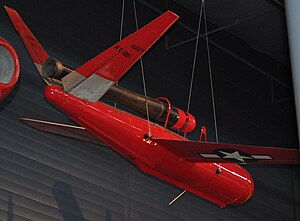m (→External links: Remove some templates. interwiki links, delink non military terms, cleanup and move Wikipedia link above categories) |
m (→Specifications (KDD-1): Remove some templates. interwiki links, delink non military terms and cleanup, replaced: == → ==) Tag: apiedit |
||
| Line 29: | Line 29: | ||
The most unique features of the TD2D were the externally-mounted [[pulsejet]] engine and the [[V-tail]]. The gasoline-powered, {{convert|8|in|0|adj=on}} diameter engine was built by McDonnell, but it is unclear how much it was derived from the [[Argus As 014|Argus pulsejet]] used on the German [[V-1 (flying bomb)|V-1]]. The drone was probably named after the [[Katydid]] because it had narrow wings and made a loud, pulsing sound like a pulsejet. The drone could be either launched by [[Aircraft catapult|catapult]] from the ground or from underwing racks on [[Consolidated PBY Catalina]] [[seaplane]]s. It was gyro-stabilized, radio-controlled and could be recovered by parachute. |
The most unique features of the TD2D were the externally-mounted [[pulsejet]] engine and the [[V-tail]]. The gasoline-powered, {{convert|8|in|0|adj=on}} diameter engine was built by McDonnell, but it is unclear how much it was derived from the [[Argus As 014|Argus pulsejet]] used on the German [[V-1 (flying bomb)|V-1]]. The drone was probably named after the [[Katydid]] because it had narrow wings and made a loud, pulsing sound like a pulsejet. The drone could be either launched by [[Aircraft catapult|catapult]] from the ground or from underwing racks on [[Consolidated PBY Catalina]] [[seaplane]]s. It was gyro-stabilized, radio-controlled and could be recovered by parachute. |
||
| − | ==Specifications (KDD-1) |
+ | ==Specifications (KDD-1)== |
{{Aircraft specs |
{{Aircraft specs |
||
|ref=Placard at Udvar-Hazy and KDH webpage |
|ref=Placard at Udvar-Hazy and KDH webpage |
||
Revision as of 05:36, 4 October 2015
| TD2D/KDD/KDH Katydid | |
|---|---|
| McDonnell KDD on display at the Steven F. Udvar-Hazy Center | |
| Role | Target drone |
| National origin | United States |
| Manufacturer | McDonnell Aircraft |
The McDonnell TD2D Katydid was an American target drone produced by McDonnell Aircraft that began development in 1942.
History
The U. S. Navy awarded McDonnell Aircraft a contract for a radio-controlled target drone in 1942 under the designation of XTD2D-1 for anti-aircraft and aerial gunnery practice. Production models, built in unknown quantity, used the designation of TD2D-1. The Navy changed its designation system in 1946 and the XTD2D-1 and TD2D-1 were redesignated as XKDD-1 and KDD-1, respectively. Later that year, the Navy changed McDonnell's manufacturer code letter from "D" to "H", and the KDD-1 was redesignated again as KDH-1.
Description
The most unique features of the TD2D were the externally-mounted pulsejet engine and the V-tail. The gasoline-powered, 8-inch (203 mm) diameter engine was built by McDonnell, but it is unclear how much it was derived from the Argus pulsejet used on the German V-1. The drone was probably named after the Katydid because it had narrow wings and made a loud, pulsing sound like a pulsejet. The drone could be either launched by catapult from the ground or from underwing racks on Consolidated PBY Catalina seaplanes. It was gyro-stabilized, radio-controlled and could be recovered by parachute.
Specifications (KDD-1)
Data from Placard at Udvar-Hazy and KDH webpage
General characteristics
- Crew: None
- Length: 11 ft 2 in (3.40 m)
- Wingspan: 12 ft (3.7 m)
- Gross weight: 320 lb (145 kg)
- Powerplant: 1 × McDonnell 8-inch (203 mm) pulsejet, 55 lbf (0.24 kN) thrust
Performance
- Maximum speed: 250 mph (402 km/h; 217 kn)
- Endurance: 40 minutes
References
- This article contains material that originally came from the placard at the Steven F. Udvar-Hazy Center.
External links
| ||||||||||||||||||||||||||
| |||||||||||||||||||||||||||||||||||||||||
The original article can be found at McDonnell TD2D Katydid and the edit history here.
